BRANCUSI: CARVING THE ESSENCE
HAPPENINGText: Alma Reyes
Alongside Henry Moore, Alexander Calder, Auguste Rodin and Alberto Giacometti, the name Constantin Brancusi may be overlooked as one of 20th century’s leading sculptors. Brancusi was a pioneer in the emphasis of pure form and thorough investigation of natural materials. His delicately carved work of plaster The Kiss (1907-10) served as a significant representation of the Symbolism era. The movement prompted him to inspire acute artistic expression, as manifested by the sculpture’s gesture of the powerful bond between a man and a woman, wrapped inseparably by their soft, embracing arms, imparting simplicity and intimacy in a single block.

Constantin Brancusi, The Kiss, 1907–10, Artizon Museum, Ishibashi Foundation
This magnificent piece of art can be viewed at “Brancusi: Carving the Essence” currently showing at Artizon Museum in Tokyo until July 7 this year. The first Brancusi solo exhibition ever held at an art museum in Japan, this showcase presents around ninety works, including sculptures, paintings, drawings, and photographs made possible by the cooperation of the Brancusi Estate and various museums and private collections both in Japan and overseas. Two sculptures (The Kiss and Mademoiselle Pogany II) come from the Ishibashi Collection of the Artizon Museum. The exhibition covers collections from the artist’s early life when he gained influence of academic realism and styles of Rodin, up to the 1910s, when he dwelled in the purer and abstract approach leading to the connection between concept and physical forms.

Constantin Brancusi, Mademoiselle Pogany II, c. 1920, Artizon Museum, Ishibashi Foundation
The display of sculptures reveals Brancusi’s skillful hand in direct carving from blocks of stone, plaster or wood, with some cast in bronze, all in harmony with the materials’ natural properties. In his formative years having studied sculpture at the Bucharest School of Fine Arts in Romania before moving to Paris in 1904, his early pieces clearly outlined the touch of naturalism, such as in Pride (1905), evocative of the academic style. However, in Suffering (1907), the model’s contorted pose evidently illustrates the emotion of anguish and aligned with the smooth surface that draws an intense impression. Here, Brancusi has begun to shift away from superficial realism towards the exploration of textures.

Constantin Brancusi, Sleeping Muse, c. 1910–11, Nakanoshima Museum of Art, Osaka *On display until May 12
From 1907, Brancusi embarked on a series of heads lying horizontally, a theme that abandoned the conventional pedestal, therefore, allowing the object to occupy more space and be freed of gravity. The forms resembled African masks, which highly influenced early 20th century Western art. The cast iron Sleeping Child (1907, cast: 1960/62) is finished exquisitely with graceful tones of light and shadow. It marks the beginning of Brancusi’s profound interest in egg-shaped forms. The same elongated shape is delineated in Sleeping Muse (c. 1910-11) in plaster, and Sleeping Muse II (1923, cast: 2010) in glossy bronze – both shying away from wide-eyed portraits and bending towards the sleepy appearance.
Read more ...







